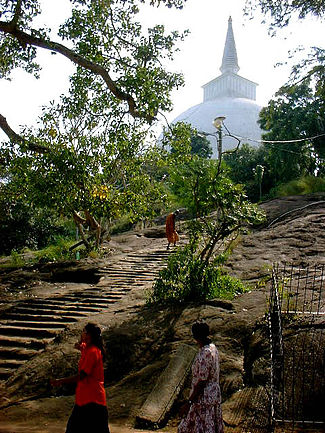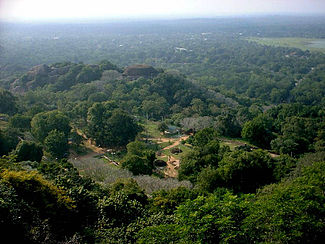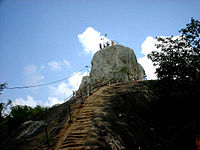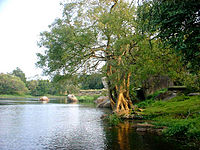- Mihintale
-
Mihintale is a mountain peak near Anuradhapura in Sri Lanka. It is believed by Sri Lankans to be the site of a meeting between the Buddhist monk Mahinda and King Devanampiyatissa which inaugurated the presence of Buddhism in Sri Lanka. It is now a pilgrimage site, and the site of several religious monuments and abandoned structures.
Contents
Description
Eight miles east of Anuradhapura, close to the Anuradhapura - Trincomalee Road is situated the "Missaka Pabbata" which is 1,000 feet (300 m) in height and is one of the peaks of a mountainous range. Geographically, the mountain range consists of three main hills: Ambastala Plateau of the Mango. Rajagiri, Mountain of the King, and Aanaikuddy the Mountain of the Elephant. The word 'Aanaikuddy' is Tamil. Thus, this mountain range should have some connection with the Tamils, probably the Tamil Buddhist Monks. This tempts one to ask whether the present name Mihintale was actually a name changed from the Tamil name Mahinda Malai, meaning 'the Mountain of Mahinda.' Though this is said to be called Cetiyagiri or Sagiri, it was popularly known as Mihintale - the cradle of Buddhism in Sri Lanka.
According to Dipavamsa and Mahavamsa, Thera Mahinda came to Sri Lanka from India on the full moon day of the month of Poson (June) and met King Devanampiyatissa and the people, and preached the doctrine. The traditional spot where this meeting took place is revered by the Buddhists of Sri Lanka. Therefore in the month of Poson, Buddhists make their pilgrimage to Anuradhapura and Mihintale.
However, the story of Mahinda meeting the King Devanampiyatissa of Anuradhapura and preaching him the doctrine as said in Dipavamsa and Mahavamsa is very similar to the story of Satuvan meeting the leader of the Nagga Nagas and preaching him about the good way of life in the Tamil epic Manimehala. There are a number of description in Manimehalai that are same or similar to that of Dipavamsa and Mahavamsa.
From ancient times a large number of large steps were constructed to climb Mihintale. It is stated that King Devanampiyatissa constructed a vihara and 68 caves for the bhikkhus to reside in. At Mihintale there gradually grew a number of Buddhist viharas with all the dependent buildings characteristic of monasteries of that period.
The Hospital
At the foot of the mountain are the ruins of a hospital, medical bath (or stone canoe in which patients were immersed in medicinal oil) a stone inscription and urns belonging to the ancient period have been unearthed. Between the hospital and the steps leading to the rock are the ruins of a large monastery. On the floors of the square building which is 125 feet (38 m) on one side, are beautiful carvings and also are stone balustrades and guard stones. As this side is precipitous, the steps are on the eastern side of the slope, spacious and in 4 sections. The stairway has 1840 steps made of granite, leading to the summit. At the end of the first set of steps on the right side of the plain, is a small mountain peak. On this is situated the most famous Kantaka Cetiya.
Heinz E Müller-Dietz (Historia Hospitalium 1975) describes Mihintale Hospital as being perhaps the oldest in the world.
Kantaka Cetiya
Kantaka Cetiya is a circular stupa having a base circumference of about 425 feet. It has three stepped rims. It has four frontispieces in the four cardinal directions. The frontispiece is called Vaahalkada. All the Vaahalkadas are decorated with sculptures of dwarfs, animals, human, divine figures and floral motifs. One of the most important of the sculptures on the Kantaka Cethiya Vaahalkada is the elephant headed God with two arms. The Saivites call it Ganapati or Ganeesaa. The Ganapati sculptures in the Vaahalkadas of the Kantaka Cetiya have created confusion among the archaeologists and historians. No one could not explain the connection between Ganapati God and Buddhism. Thus, the Sinhalese historians and archaeologists have tried to give some imaginary interpretation.
The four vahaalkadas facing the four cardinal points have different animals on the top of the square pillars - the elephant on the east, the lion on the north, the horse on the west and the bull on the south.
Most of the Indian and Sri Lankan archaeologists believe that there is a symbolic relationship between these animals and the four cardinal directions. But, they differ in associating a particular animal with a particular direction.
However, in a moonstone of Sri Lanka and the Lion Capital of Saranath, we find these four animals sculptured in the moving position. At the same time, in the coins collected in the Northern mainland of Sri Lanka, Jaffna peninsula and Akurugoda of Rununa, we find the following symbols marked on them: 1. the Lion on one side, and a group of four dots placed in the form of a square at the centre of a circle on the other side; 2. the Horse on one side and a group of four dots placed in the form of a square at the centre of a circle on the other side; 3. the Bull on one side and a group of four dots placed in the form of a square at the centre of a circle on the other side.
Also in the Northern and southern Sri Lanka, coins having a bull on one side and an an elephant on the other sidehave been discovered. In India coins with a bull on one side and a lion on the other side have been discovered.
Therefore, the animals lion, horse and bull are associated with the very same group of four things.Therefore, the animals lion, horse and bull must symbolize a human who is associated with a group of four things.
Thus, one could come to the conclusion that the four animals lion, horse , elephant and bull symbolize Lord Buddha who is associated with the Four Noble Truths. Further study on coins, sculptures etc. will confirm this conclusion.
Therefore, the Kantaka Cethiya could have been built by the Mahayana Buddhists only, as Theravada Buddhism rejects literature, puraanas, symbolization, symbolization of Lord Buddha and Buddhism, music, dance, sculpture, painting and other forms of art.
On the other hand, Tamil name 'Aanaikuddy' and the compound word 'Vaahalkada' compels one to conclude that the Kantaka Cetiya was built by the Tamil Mahayana Buddhists and the name 'Mihintale' should have been Mahinta Malai.
Thus, a further study has to be conducted on Kantaka Cetiya.
However, the Sinhalese archaeologists and historians say that King Suratissa may have built this Stupa. The Pesavalalu and the frontispiece have been preserved to a great extent. There are ruins of the stupa which are 40 ft (12 m) in height. The monks would have resided in the caves close to the stupa. As this stupa was renovated by King Lajjitissa. There is no doubt that this belongs to the 1st century B.C.
The Refectory
The Courtyard is situated at the end of the third flight of steps. To the left of the courtyard is the refectory. The quadrangle is 62 feet (19 m) in length and 25 ft (7.6 m) in breadth and is surrounded by the storeroom. Since a part of a pipe line has been discovered here, it can be concluded that a systematic and well planned pipe borne scheme was provided. Two stone troughs can be seen here, which would have been used to store food close to the refectory. On either side of the entrance to a building, are 2 inscriptions engraved on 2 large slabs of granite known as the Mihintale stone inscriptions. The rules and regulations pertaining to the administrative purposes of the monastery are engraved on these 2 stone slabs. This inscription installed by King Mihindu (956 - 976 AD) contains records of payments made to the service staff. In the vicinity on another plain is the meeting hall of the monks. Here the monks met, to discuss the Dhamma and the Vinaya. This is an open building which is 62 feet (19 m) square and was constructed on 48 stone pillars. In the middle of the hall is a platform with 4 entrances.
To the East of the refectory is a stupa, 88 feet (27 m) in circumference. It has not been identified so far.
Ambasthala Dagaba
Is situated on the plain close to the peak of the mountain, and is said to have been built by King Makalantissa. The ruins show that there has been a house built encircling the stupa. The Dagaba itself is said to enshrine the relics of the great Apostle Mahinda. It is here that King Devanampiyatissa first met Arahant Mahinda. The traditional spot where this meeting took place is marked by the Ambasthala Dagaba.
The Cave of Arahant Mahinda
When proceeding from Ambastala dagaba along the narrow road, on the slope is the cave known as Mihindu Guhawa or the cave of Arahant Mahinda, where he resided. Out of the caves the most famous and incidentally the most sacred to Buddhists is this cave with its flattened slab on which Thera Mahinda was accustomed to rest.
Maha Stupa
This large stupa known as the Maha Saya is on the summit of the Mihintale hill, built by King Mahadathika Mahanaga (7-19 AD) the base of which is 136 ft (41 m) in diameter. The stupa which was in a dilapidated condition was completely restored.
Aradhana Gala
Which faces Maha Seya is on a summit of a hill. Even during very windy weather pilgrims do not fail to visit this rock, which has iron railings to help them to climb. In the ancient books such as the Mahavamsa it is written that Mahinda came to Sri Lanka by travelling through the air. He came down and landed at Sri Lanka on the top of the Aradhana Gala.
Naga Pokuna Passing Ambasthalaya on the western side are a flight of steps. When going down the steps one could see the Naga Pokuna. This has been constructed by King Agbo I and its name is derived as there are figures of snakes with their hoods spread out in the back ground and is one of the most famous ponds.
Kaludiya Pokuna
Is also one of the famous ponds at Mihintale. The name is derived from the fact that the water in the pond appears to be black in colour. It is believed that on new moon day Kalu Buddha Rakkhita Thera sat under the Thimbiriya tree, close to the Kaludiya Pokuna, preached on sermon based on Kalakarama Sutta. The word "Kalu" means black. The word "diya" means water, and the word "pokuna" means pond.
See also
- Buddhism
- Mahawamsa
- Anuradhapura
External links
- This page incorporates content from Dr. Rohan Hettiarachchi's Lanka Library.
Coordinates: 8°21′02.14″N 80°31′01.00″E / 8.3505944°N 80.51694°E
Categories:- Archaeological sites in Sri Lanka
- Religion in Sri Lanka
Wikimedia Foundation. 2010.







